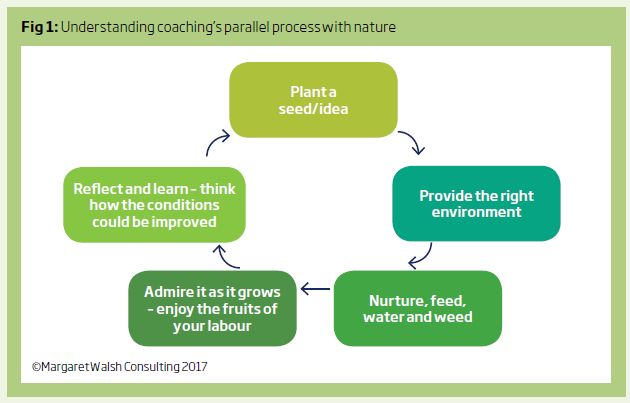If you knew that you could help your clients to make a deeper connection with their inner worlds and ease some of the stress that they might be experiencing, would you test out the idea? If yes, then a closer connection to nature offers this potential gain.
Nature is within us and surrounds us and still we can so easily become disconnected from it. With the current pace of life, we find that many people tune out of themselves and the world and connect with technology instead. This often results in a shutting down of parts of their inner world. Many clients report the benefits of coaching as giving them ‘a space to think’ although, ironically, coaches often feel an internal pressure to ‘prove their worth’, through the clever use of tools and theories. The coaching process can then start to look, and feel, much more like an intellectual exercise, where only the conscious part of the brain is engaged. With developments in neuroscience suggesting that most of our thoughts and behaviour come from our unconscious processing, so much more could be gained from tapping into a client’s ‘hidden nature’.
Harvard biologist, Edward Wilson, examined our connection with nature and expanded the concept of biophilia (a love of living systems), which he articulated as ‘the connection that human beings subconsciously seek with the rest of life’.1
The role of nature in coaching
Coaching involves working with the inner world, and in 2016, Natural England published a report, which estimated that, each year, one in four people will experience a ‘significant’ mental health problem. It reports: ‘there is now compelling evidence to show that contact with nature and the outdoors improves physical health and mental wellbeing’.2 So, knowing that nature can enhance mental wellbeing, when does it get used in coaching?
My experience of coaching is that it is delivered in traditional ways, often in a bland office, with little or no connection to the natural world. However, when you stop and listen to the language of a coach, there are numerous references to nature/gardening such as ‘sowing the seeds’, ‘nurture’, ‘adapting to the environment’, ‘use of tools to improve performance’ or ‘managing your boundaries’.
The processes involved in growing a plant are, indeed, very much like the processes followed when developing a new idea or, for example, deepening self-awareness, as captured in the cycle in Figure 1 below.

One of the most popular frameworks for coaching is GROW – Goals, Reality, Options and Way Forward – developed by the late Sir John Whitmore in the 1980s.3 Perhaps, unconsciously, it contains a ‘nod’ to nature.
Nature as a metaphor in coaching
A metaphor helps us to gain clarity by identifying hidden similarities between two ideas. In coaching, one of the key objectives is often to increase a client’s self-awareness, and nature provides a perfect example of many of the issues that individuals grapple with, like change and resilience. By tuning in more closely to nature, there is scope for clients to tune in more closely to their own, perhaps hidden, nature and to develop a stronger connection to both. We also see first-hand in nature that every day differs from the next, but there is also reassurance in the repetition. A garden builds layers over the years and enriches its space. It also teaches us the payback of effort, as the more you put into a garden, the more you gain, and also that results take time.
Additionally, a garden encourages us to pay attention to the here and now. Nature provides a place to feel grounded and rooted in the moment, thus allowing an exploration of our inner landscape and imagination. Often, there can be a different sense of time that is measured in more natural ways, like the growth of a plant, rather than in minutes and hours.
Understanding our own coaching nature
The factor identified by Asay and Lambert as being most vital to successful outcomes in one-to-one therapeutic work, which can be transposed to coaching, is the quality of the relationship between coach and client.4 To achieve a robust coaching relationship, it is important that, as coaches, we have excellent self-awareness so that we do not bring our own biases or preconceptions into the coaching space. While no ethical coach would consciously do this, we are all subject to our own unconscious processes, and gaining insight into these is part of our continuing professional development (CPD).
So, why not build in time in your own CPD for a better connection to nature and see what happens? When we are in nature, we are aware of the rhythms and cycles of the seasons and of the changes in the world, and these can also connect us with the changes that exist within us.
How to integrate nature into coaching
- Use nature as a metaphor and work with the seasons and not against them – the use of nature as a seasonal process offers rich opportunities to explore the changing cycles of life. For example, there is a slower pace in the garden in wintertime, which gives us time to think, as there is often not the frenzy of activity associated with the other seasons. In winter, we can see more of the underlying structure of things. We can create our own ‘winter’ in our lives (and those of our clients), which gives time for planning and building in change.
- It is so easy to sit in an anonymous office and for coaching to start in that way, but take time to consider how the coaching space is decorated. Consider displaying pictures of nature and bringing in seasonal flowers, berries, or pine cones. This does not need to be expensive or time-consuming, but shows an awareness of the changes and development in the wider, natural world and this can influence change in the coaching space.
- Work outdoors, although be mindful of confidentiality. There may be times when a walk would help to shift a client’s thinking or feelings in more productive and imaginative ways than can be achieved sitting still in an office.
- Encourage clients to grow something, to observe the process of growth and to tune in to this as a metaphor for ‘growing’ an idea or project of their own. When we notice the needs of a plant and maximise its conditions for growth, this can facilitate learning about our own nature and how best to respond to our own needs.
Obviously, coaching outdoors is not the norm and so it would be good practice and ethical to ensure the client is happy before proceeding.
Some issues to consider in advance are:
- Unpredictability of the weather – have a plan to address ‘bad’ weather.
- Maintaining confidentiality – consider the environment and material you cover if working outside so that you manage confidentiality.
- Timing and maintaining boundaries – practical measures like setting a timer on your phone could assist here. Also, be aware you need to stay in your professional role as coach.
- Safety and risk assessment – while this does not need to be complex, a sensible assessment of the client’s fitness and the terrain and distance to be covered should suffice.
None of these issues is insurmountable – they just require a little bit of planning. While working in nature may not suit all clients, it may be useful or inspiring for many.
Inspire and learn
The practice of looking deep into nature to gain insight is used by people from mathematicians and scientists, to architects and professionals, who construct buildings, develop new drugs and design IT networks based on what they find in nature. Nature also inspires legions of artists, poets and writers.
Inviting nature to become a part of the coaching conversation adds another dimension to the process of change. When exposed to nature, people often connect more deeply and can have profound shifts of awareness. In our modern technological age, where connection with our emotions and inner world is under threat, it is important to consider how we can use nature in coaching. Deep down, we know that our connection to nature is important.
Margaret Walsh is a coach/psychotherapist interested in what is happening beneath the surface of our awareness that drives our behaviour. Margaret has worked in senior HR roles across all employment sectors and is a Fellow of the Chartered Institute of Personnel & Development. As a practising MBACP psychotherapist and registered coach with the Association for Coaching, she has integrated her deep-level psychological knowledge and interest in nature to develop a new coaching masterclass. Margaret also writes a regular blog at margaretwalshwork.blogspot.co.uk.
This article first appeared in the October 2017 edition of Coaching Perspectives and is reproduced here with the permission of the Association for Coaching.
References
1 Wilson E. Biophilia: the human bond with other species. NY: Harvard University Press; 1990.
2 Bragg R. Atkins G. A review of nature-based interventions for mental health care. Natural England Commissioned Reports, Number 204; 2016.
3 Whitmore J. Coaching for performance. London: Nicholas Brealey Publishing Ltd; 1994.
4 Asay TP, Lambert MJ. The empirical case for the common factors in therapy: quantitative findings. Washington DC: American Psychological Association; 1999.
